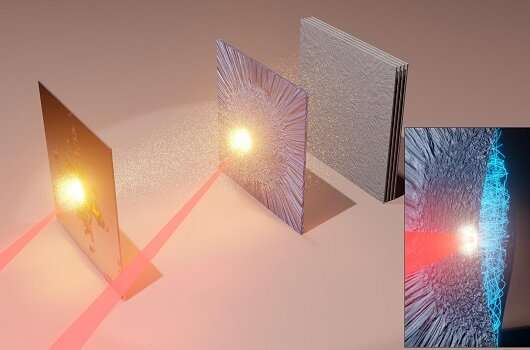#Imaging magnetic instabilities using laser accelerated protons
“#Imaging magnetic instabilities using laser accelerated protons”

The magnetic structures resulting from a plasma instability predicted by the physicist Erich Weibel about 50 years ago have been evidenced at surprisingly large scales in a laser-driven plasma in the prestigious journal Nature Physics. This instability is also expected to operate in astrophysical settings where it is held responsible for the acceleration of cosmic rays and the emission of gamma photons in the famous “gamma-ray bursts.”
Julien Fuchs, a graduate of the Institut national de la recherche scientifique (INRS) and a researcher at the Laboratoire pour l’utilisation des lasers intenses (LULI) in France, INRS Professor Patrizio Antici, a specialist in laser-driven particle acceleration, and INRS Professor Emeritus Henri Pépin have succeeded in measuring the magnetic fields produced by Weibel instabilities within a laser-driven plasma, an ionized gas. Their results were published on June 1 in Nature Physics.
The researchers used the proton radiography technique to visualize this extremely fast phenomenon. “Our protons accelerated by laser-plasma interaction are able to take a sequence of images of very fast electromagnetic phenomena, lasting a few picoseconds only and with a resolution of a few microns. This allows us to probe instabilities with precision unmatched by other imaging techniques,” reports Patrizio Antici, who did his thesis under the supervision of Professor Fuchs, himself formerly under the direction of Professor Pépin.
These three generations of researchers recreated a ‘small-scale model’ of astrophysical phenomena in the laboratory by irradiating a target with an intense laser. The magnetic fluctuations generated by the interaction can be probed by protons on a series of sensitive films, producing a sequence of images showing the temporal evolution of the magnetic structures.
The interpretation and modeling of these structures were conducted by Laurent Gremillet and Charles Ruyer, physicists at the Commissariat à l’énergie atomique et aux énergies alternatives (CEA). After several years of hard work, combining theoretical modeling and advanced numerical simulations, they highlighted the growth of two variants of the Weibel instability according to the region of the plasma where they develop.
With more powerful lasers, researchers will be able to reproduce and analyze even more extreme astrophysical phenomena with unrivaled resolution.
More information:
C. Ruyer et al, Growth of concomitant laser-driven collisionless and resistive electron filamentation instabilities over large spatiotemporal scales, Nature Physics (2020). DOI: 10.1038/s41567-020-0913-x
Provided by
Institut national de la recherche scientifique – INRS
Imaging magnetic instabilities using laser accelerated protons (2020, June 24)
retrieved 24 June 2020
from https://phys.org/news/2020-06-imaging-magnetic-instabilities-laser-protons.html
This document is subject to copyright. Apart from any fair dealing for the purpose of private study or research, no
part may be reproduced without the written permission. The content is provided for information purposes only.
If you want to read more Like this articles, you can visit our Science category.
if you want to watch Movies or Tv Shows go to Dizi.BuradaBiliyorum.Com for forums sites go to Forum.BuradaBiliyorum.Com


